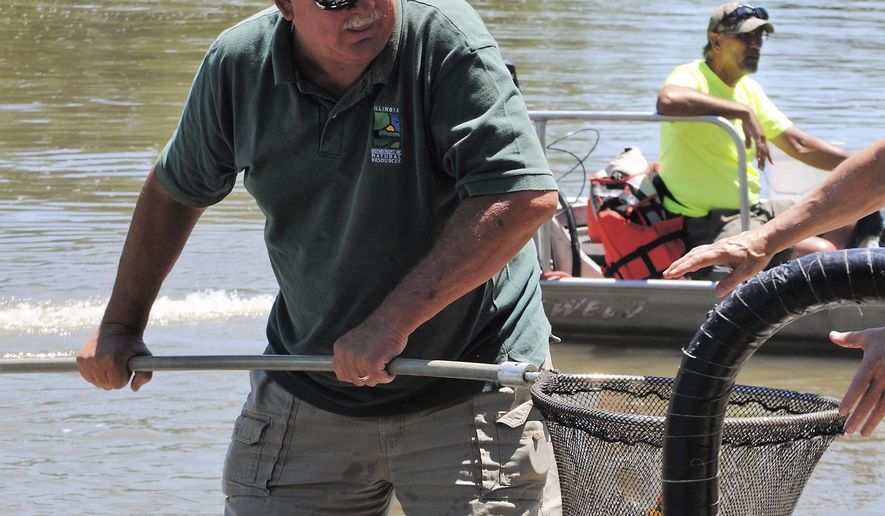KANKAKEE, Ill. (AP) - When Mazonia Lakes State Fish and Wildlife Area was added to Illinois Department of Conservation properties in 1986, it was a collection of coal strip mine lakes on 1,017 acres served by a dirt - and sometimes mud - road.
Kankakee native and self-described river rat Mark Meents was the property supervisor of the new site, having transferred from eight years as a ranger and assistant superintendent of Kankakee River State Park.
Now, it’s Mazonia-Braidwood Fish and Wildlife Area and includes the 2,640-acre Braidwood Lake property owned by Commonwealth Edison and 1,650 more acres of strip mines west of Essex.
Meents, 61, retired Jan. 1 from the Illinois Department of Natural Resources after 39 years.
He started his state career in 1978 as a ranger at Kankakee River State Park, became assistant superintendent there and moved on to become superintendent of the then-new Mazonia Lakes Fish and Wildlife Area in 1986.
After years of improving the property, formerly leased by ComEd to private fishing and hunting clubs, Mazonia was opened in 1990, with a crowd estimated at 2,000 showing up at the property, purchased through the leadership of then-state Sen. Jerry Joyce, of Essex.
Meents recalled he started at Mazonia “with a pick-up truck and an end-loader and a chainsaw and said, ’Let’s build a park.’” The entrance was a mud lane off Houston Road east of Old Route 66 (Illinois 53), a mile south of Braceville.
Then, in 1990, the state leased the 2,600-acre Braidwood Lake, owned by Commonwealth Edison and providing cooling water for the Braidwood Nuclear Power Stations. It was added to the Mazonia site and opened in October 1991, with 500 people showing up for the start of a 10-day fall-fishing season, with the first waterfowl hunting season to begin in November.
In the past 16 years, the annual Fishing For A Cure bass tournaments, sponsored by ComEd and its Braidwood Nuclear Power Station employees, have raised $500,000 for charities, including more than $50,000 last year for the Braidwood Area Healthy Community Coalition - a front-runner in the area’s campaign against drug and alcohol abuse.
In November 1999, the state added another 1,650 acres of strip mine lakes and lands west of Essex as the first purchase for $7 million in then-Gov. George Ryan’s $160 million open lands initiative and a project also pushed by Joyce and other area state legislators. The purchase included Monster Lake, where Walter Klenzak, of Kankakee, caught the still-reigning state record 26-pound, 15-ounce northern pike on Nov. 9, 1989.
Meents said the Mazonia-Braidwood Fish and Wildlife Area now draws about 800,000 visitors per year - anglers, waterfowl hunters and other nature enthusiasts, including fossil hunters hoping to find Tully monster fossils for which the region is famed. The prehistoric “monster” has been found in numerous fossils from 3 inches to a foot long, but only in the Mazon Creek region of Illinois, famed for fossils. The first was found in 1958 by amateur paleontologist Frank Tully, of Lockport. It was later named the state fossil of Illinois.
Recent additions to Braidwood-Mazonia have been resident bald eagles, sandhill cranes and flocks of western white pelicans flying above and floating on the lake “in rafts all over the place,” Meents said. “I had a guy come in the office and say: ’Tell me I’m not losing it. Did I just see a pelican on Braidwood Lake?’”
Meents grew up a river rat in Kankakee “one block south of the 4th Avenue hole, and every day, I would head out to the river with a fishing pole or go out clamming (for fish bait) in the early ’60s.”
With an associate’s degree in law enforcement, he hoped to become a game warden, but started his career as a ranger at the state park, then advanced to assistant superintendent there until his promotion to run Mazonia-Braidwood.
In 1981-82, Kankakee River State Park became a problem site for youth beer, booze and drug parties, fights and occasional fatal accidents on Illinois Route 102, Meents said. Traffic in the park “was so bad it took 45 minutes to get from one end of the park to the other. We had to close down at 10 o’clock at night and that didn’t mean anything for some kids. We had people with hatchets and axes, chopping down whatever they could for firewood … groups of people fighting. Crazy stuff.”
He was assigned to second shift, patrolling on horseback. “Things were rough back then,” he said. “It became the first state park to impose an alcohol ban,” he said. “I used to have T-shirts made up saying, ’I survived summer at Kankakee River State Park.’”
Such problems are history now, but the park closes even earlier - 6 p.m. from October through March and 8 p.m. April-September. Campgrounds’ quiet time begins at 10 p.m., although both Potawatomi and Chippewa campgrounds have been closed in recent years because state funding for improvement projects has been shut off.
In retirement, Meents said, “I’m basically doing what my wife (Patty) tells me to do” - possibly a joke. Then, he added, “I’ve got a lot of golf still left in me and fishing and I’m going to stay involved in local outdoors activities here. I’m still concerned about the Kankakee River.”
His replacement at Mazonia-Braidwood hasn’t been announced.
___
Source: The (Kankakee) Daily Journal, http://bit.ly/2DFVcIY
___
Information from: The Daily Journal, http://www.daily-journal.com




Please read our comment policy before commenting.